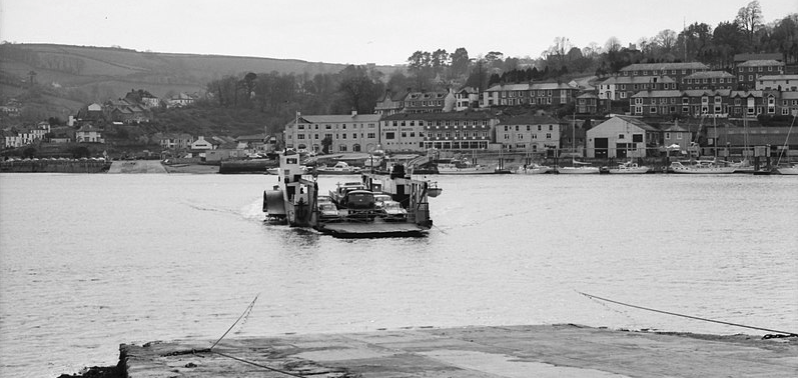
Pre 1800’s
As early as 1365 there is a mention of a ferry crossing the River Dart. The only regular ferry across the harbour was from Kingswear connecting with the old road from Brixham, which for centuries had been the private property of the Luttrell Estate.
1800’s
In 1828, James Meadows Rendel, a civil engineer from Devon and John Foulston, a Plymouth architect, designed a suspension bridge, to be built across the River Dart between Dittisham and Greenway. The project was abandoned because of local opposition, as were two further attempts.
It was in direct consequence of this third attempt and the disappointment of its ultimate abandonment, that the Dartmouth Floating Bridge was conceived.
James Meadows Rendel’s design was for a twin hull construction, 40 feet long and 30 feet wide and divided lengthways into three sections. The two outer sections for carrying carriages, pedestrians and cattle, while the centre section, covered by an awning, was adapted to carry a steam engine of about 4hp and two boilers. The vessel was propelled across the river upon two cast iron chains and these were fixed to large granite blocks on opposite shores. Isaac Blackburn built this first Floating Bridge, in 1829, at Turnchapel in Plymouth.
This Floating Bridge was not a commercial success so in 1836, two horses (rumoured to be blind) working a treadmill winch amidships, replaced the steam engine. The unfortunate animals were required to follow each other’s weary footsteps, round and round, day after day.
In September 1855, the Floating Bridge sank at its moorings during a violent storm, repair was impracticable.
In October 1856, Sir Henry Seale replaced the old Floating Bridge with a new one. It too was worked across the river on chains, by horses operating a treadmill. This horse/treadmill system remained in use until 1867.
In 1867, steam replaced the horse, Philip and Son Ltd, Shipbuilders of Dartmouth since 1858, built a new Floating Bridge and reintroduced steam power.
The new Ferry was 52 feet long and powered by steam engine and capable of crossing the river in three minutes.
In 1896, a new Ferry went into service. Philip & Son built this Ferry. It was powered by a 90-hp steam engine – still running on chains.
1900’s
In 1908, the Ferry service stopped and the Ferry was left abandoned at Sandquay. There was no service for four years.
Raleigh Estates sold the Floating Bridge to the owner of the Torpoint Chain Ferry Mr John Williams in 1912. He immediately ordered a new ferry to be built at Cremyll Shipyard. This ferry went into service in November 1912. For the first time ever, chains were replaced by wire ropes.
In 1918, the Ferry was put up for sale and bought by Philip & Son for £1,900.
The Company’s first step was to build a new ferry and the service was suspended for 18 months whilst this Ferry was being constructed. The new Ferry used the old engine and boiler from the previous Ferry. It was 55 feet long and designed to carry eight/ten cars and showed Philip’s determination to put its Ferry on a commercial and profitable basis. This Ferry was propelled across the river by paddle wheels, running on wire ropes and came into service in 1920.
The system of using wire ropes is still in use today. The wire ropes were ex-colliery ropes until the late 80s when they became very difficult to obtain.
In 1960, a new ferry came into operation, designed to carry 15 cars. This Ferry was diesel-electric. A 165 hp, 6 cylinder Dorman Engine drives a 400-volt generator which supplies power to the heavy duty electric motors that in turn drive the paddles.
A new shaped wheelhouse was fitted in January 1999, as a safety feature to give better vision.
21st Century
On 1st July 2001, weight limits were introduced, reducing the maximum weight per vehicle from 16 tonnes to 7½ tonnes
On Monday 15th June 2009, hundreds of people lined the River Dart to welcome the new Dartmouth to Kingswear Higher Ferry. The new Higher Ferry, which was completed by Pendennis super yacht builders of Falmouth, Cornwall, was accompanied by an official Naval escort. With almost double the capacity of the old Higher Ferry and simultaneous loading and disembarking systems, the new Dartmouth Higher Ferry makes crossing the Dart quicker and more efficient.
The weight limit was increased back to 16 tonnes in July 2009.And raised again in 2012 up to 18 tonnes.